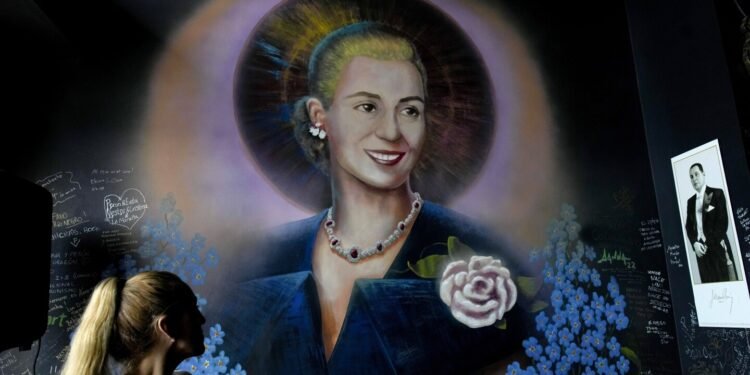BUENOS AIRES, Argentina (news agencies) — Early every morning, just as she reaches her workplace at a labor union in Buenos Aires, Ángeles Celerier heads to the chapel and prays to Saint Cajetan, Saint Teresa and Eva Perón.
Perón — unlike the others — has not been canonized by the Vatican, but this doesn’t matter to Celerier.
“For me, she is the saint of the people,” the 56-year-old Argentinian said.
Many union members think of Evita as their patron or gaze at her photos with nostalgia, feeling that she and her husband, three-time President Juan Domingo Perón, brought prosperity to their country through an equality and social justice-driven movement that was named after him in the 1940s: Peronism.
That movement is currently the biggest opposition force in Argentina. And some political observers attribute the recent vote to elect President Javier Milei as a means to defeat Peronism and its previous hold on the presidency.
“For us, she is the spiritual reservoir of the people,” said Julio Piumato, human rights director at the largest union in Argentina. He signed a 2019 document requesting Evita’s beatification.
“No other figure has a deeper significance,” Piumato said. “The humble sectors are synthesized in Evita.”
According to the union leader, between 1946 and 1952, when Evita died of cancer at age 33 and Perón concluded his first term, the couple dignified the working class and prioritized social justice.
“Saints show us paths to reach Christ and intercede before God for us,” reads the beatification request delivered to the archbishop. “In our homeland, one generation after another continues to be converted by the humanist and Christian message of the standard bearer of the humble.”
Aside from a 1996 movie starring Madonna or Andrew Lloyd Weber’s 1978 musical, many foreigners know relatively little about this former first lady who died 71 years ago.
But in Argentina, Evita is a constant presence. Her face is printed on 100-peso bills, decorates a mural on a key government building, and greets guests from an altar placed in a restaurant called Saint Evita.
“I carry her image in my wallet, and I have it at home in a small picture frame with a candle,” Celerier said. “I ask her for protection.”
The secret behind the fascination that she awakens might be hidden in her name.
Long before becoming first lady, she called herself María Eva, a girl who left the town of Los Toldos to try her luck as an actress in Buenos Aires. As a modest film star she was known as Eva Duarte and afterwards became Eva Perón, the president’s wife. Then came Evita.
“Evita is the one who is close to the people,” said Santiago Regolo, a researcher at Museum Evita. “People began to call her that, and that construction is linked to the political and social work that distinguished her from the women who preceded her and take her as an example to this day.”
Evita was the one who paid visits to elders and single mothers. The one who handed out toys for children and bread for families. The one who promoted paid vacations for workers who had never been able to afford a break and gave a final push to achieve the women’s right to vote in 1947.
She has also inspired some feminists — who carry her photo along with their green scarves during protests — as well as a political organization that asks for social transformation using her image as a logo.
“Having Evita on our flag represents being with those in the lower classes and trying to vindicate her name over time,” said Iván Tchorek, from the Evita Movement, which has 155,000 members nationwide and was created after an economic crisis in 2001.
She’s relevant as ever, Tchorek said, because Peronism is. Thousands of workers like him recently led a general strike against the right-wing Milei, who defeated Peronist candidate Sergio Massa last November. Soon after, Milei issued a decree that would revoke or modify hundreds of existing laws in order to limit the power of unions and deregulate an economy that has traditionally featured heavy state intervention.
Even as a union standard-bearer in polarized times, Evita and her memory have the ability to transcend politics. “Certain issues are linked to matters of a sentimental, sacralized nature,” Regolo said. “She is seen as a companion, a sister, a mother for the humble.”



 Pakistan Rupee Exchange Rate
Pakistan Rupee Exchange Rate





